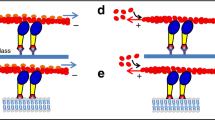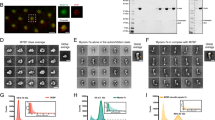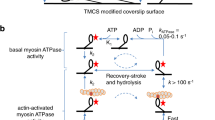Abstract
Myosin-V processively walks on actin filaments in a hand-over-hand fashion. The identical structures of the heads predict a symmetric hand-over-hand mechanism where regular, unidirectional rotation occurs during a 36-nm step. We investigated this by observing how fixed myosin-V rotates actin filaments. Actin filaments randomly rotated 90° both clockwise and counter-clockwise during each step. Furthermore, ATP-dependent rotations were regularly followed by ATP-independent ones. Kinetic analysis indicated that the two 90° rotations relate to the coordinated unbinding and rebinding of the heads with actin. We propose a 'brownian rotation hand-over-hand' model, in which myosin-V randomly rotates by thermally twisting its elastic neck domains during the 36-nm step. The brownian rotation may be advantageous for cargo transport through a crowded actin meshwork and for carrying cargoes reliably via multiple myosin-V molecules in the cell.
This is a preview of subscription content, access via your institution
Access options
Subscribe to this journal
Receive 12 print issues and online access
$189.00 per year
only $15.75 per issue
Buy this article
- Purchase on Springer Link
- Instant access to full article PDF
Prices may be subject to local taxes which are calculated during checkout






Similar content being viewed by others
References
Reck-Peterson, S.L., Provance, D.W., Jr., Mooseker, M.S. & Mercer, J.A. Class V myosins. Biochim. Biophys. Acta 1496, 36–51 (2000).
Cheney, R.E. et al. Brain myosin-V is a two-headed unconventional myosin with motor activity. Cell 75, 13–23 (1993).
Miller, K.E. & Sheetz, M.P. Characterization of myosin V binding to brain vesicles. J. Biol. Chem. 275, 2598–2606 (2000).
Vale, R.D. The molecular motor toolbox for intracellular transport. Cell 112, 467–480 (2003).
Walker, M.L. et al. Two-headed binding of a processive myosin to F-actin. Nature 405, 804–807 (2000).
Yildiz, A. et al. Myosin V walks hand-over-hand: single fluorophore imaging with 1.5-nm localization. Science 300, 2061–2065 (2003).
Mehta, A.D. et al. Myosin-V is a processive actin-based motor. Nature 400, 590–593 (1999).
Howard, J. The movement of kinesin along microtubules. Annu. Rev. Physiol. 58, 703–729 (1996).
Ali, M.Y. et al. Myosin V is a left-handed spiral motor on the right-handed actin helix. Nat. Struct. Biol. 9, 464–467 (2002).
Hua, W., Chung, J. & Gelles, J. Distinguishing inchworm and hand-over-hand processive kinesin movement by neck rotation measurements. Science 295, 844–848 (2002).
Asbury, C.L., Fehr, A.N. & Block, S.M. Kinesin moves by an asymmetric hand-over-hand mechanism. Science 302, 2130–2134 (2003).
Ariga, T., Masaike, T., Noji, H. & Yoshida, M. Stepping rotation of F(1)-ATPase with one, two, or three altered catalytic sites that bind ATP only slowly. J. Biol. Chem. 277, 24870–24874 (2002).
Rief, M. et al. Myosin-V stepping kinetics: a molecular model for processivity. Proc. Natl. Acad. Sci. USA 97, 9482–9486 (2000).
Watanabe, T.M. et al. A one-headed class V myosin molecule develops multiple large (approximately 32-nm) steps successively. Proc. Natl. Acad. Sci. USA 101, 9630–9635 (2004).
Howard, J., Hudspeth, A.J. & Vale, R.D. Movement of microtubules by single kinesin molecules. Nature 342, 154–158 (1989).
Svoboda, K., Schmidt, C.F., Schnapp, B.J. & Block, S.M. Direct observation of kinesin stepping by optical trapping interferometry. Nature 365, 721–727 (1993).
Hannemann, D.E., Cao, W., Olivares, A.O., Robblee, J.P. & De La Cruz, E.M. Magnesium, ADP, and actin binding linkage of myosin V: evidence for multiple myosin V-ADP and actomyosin V-ADP states. Biochemistry 44, 8826–8840 (2005).
Gebhardt, J.C., Clemen, A.E., Jaud, J. & Rief, M. Myosin-V is a mechanical ratchet. Proc. Natl. Acad. Sci. USA 103, 8680–8685 (2006).
Vale, R.D., Soll, D.R. & Gibbons, I.R. One-dimensional diffusion of microtubules bound to flagellar dynein. Cell 59, 915–925 (1989).
De La Cruz, E.M., Wells, A.L., Rosenfeld, S.S., Ostap, E.M. & Sweeney, H.L. The kinetic mechanism of myosin V. Proc. Natl. Acad. Sci. USA 96, 13726–13731 (1999).
Forkey, J.N., Quinlan, M.E., Shaw, M.A., Corrie, J.E. & Goldman, Y.E. Three-dimensional structural dynamics of myosin V by single-molecule fluorescence polarization. Nature 422, 399–404 (2003).
Dunn, A.R. & Spudich, J.A. Dynamics of the unbound head during myosin V processive translocation. Nat. Struct. Mol. Biol. 14, 246–248 (2007).
Veigel, C., Wang, F., Bartoo, M.L., Sellers, J.R. & Molloy, J.E. The gated gait of the processive molecular motor, myosin V. Nat. Cell Biol. 4, 59–65 (2002).
Okada, T. et al. The diffusive search mechanism of processive myosin class-V motor involves directional steps along actin subunits. Biochem. Biophys. Res. Commun. 354, 379–384 (2007).
Uemura, S., Higuchi, H., Olivares, A.O., De La Cruz, E.M. & Ishiwata, S. Mechanochemical coupling of two substeps in a single myosin V motor. Nat. Struct. Mol. Biol. 11, 877–883 (2004).
Baker, J.E. et al. Myosin V processivity: multiple kinetic pathways for head-to-head coordination. Proc. Natl. Acad. Sci. USA 101, 5542–5546 (2004).
Shiroguchi, K. & Kinosita, K., Jr. Myosin v walks by lever action and Brownian motion. Science 316, 1208–1212 (2007).
Toprak, E. et al. Defocused orientation and position imaging (DOPI) of myosin V. Proc. Natl. Acad. Sci. USA 103, 6495–6499 (2006).
Funatsu, T., Harada, Y., Tokunaga, M., Saito, K. & Yanagida, T. Imaging of single fluorescent molecules and individual ATP turnovers by single myosin molecules in aqueous solution. Nature 374, 555–559 (1995).
Spudich, J.A. & Watt, S. The regulation of rabbit skeletal muscle contraction. I. Biochemical studies of the interaction of the tropomyosin-troponin complex with actin and the proteolytic fragments of myosin. J. Biol. Chem. 246, 4866–4871 (1971).
Harada, Y., Sakurada, K., Aoki, T., Thomas, D.D. & Yanagida, T. Mechanochemical coupling in actomyosin energy transduction studied by in vitro movement assay. J. Mol. Biol. 216, 49–68 (1990).
Hunt, A.J. & Howard, J. Kinesin swivels to permit microtubule movement in any direction. Proc. Natl. Acad. Sci. USA 90, 11653–11657 (1993).
Yanagida, T., Nakase, M., Nishiyama, K. & Oosawa, F. Direct observation of motion of single F-actin filaments in the presence of myosin. Nature 307, 58–60 (1984).
Acknowledgements
This work was supported by Core Research for Evolutional Science and Technology program of the Japanese Science and Technology Corporation and the Special Coordination Funds for Promoting Science and Technology: Yuragi Project of the Ministry of Education, Culture, Sports, Science and Technology, Japan. We are grateful to O. Ohara and H. Yamakawa at the Kazusa DNA Research Institute for providing complementary DNA fragments encoding human myosin-V; T. Wazawa and H. Tanaka for technical support in the single-molecule assay; T. Mimuro-Ichinose for generating the human myosin-V construct; Y. Ishii and P. Karagiannis for critically reading the manuscript and for helpful discussions; and colleagues of the Yanagida laboratory at the Single Molecule Processes Project, Formation of Soft Nanomachines, and Osaka University for discussion.
Author information
Authors and Affiliations
Contributions
Y.K. conceived the experiments, constructed the microscopy system, devised custom software, prepared materials, performed experiments and analyzed data. A.H.I. designed, constructed and expressed recombinant myosin-V. All processes were supervised by T.Y. Y.K., A.H.I. and T.Y. wrote the manuscript.
Corresponding author
Supplementary information
Supplementary Text and Figures
Supplementary Figures 1–4, Supplementary Discussion (PDF 472 kb)
Rights and permissions
About this article
Cite this article
Komori, Y., Iwane, A. & Yanagida, T. Myosin-V makes two brownian 90° rotations per 36-nm step. Nat Struct Mol Biol 14, 968–973 (2007). https://doi.org/10.1038/nsmb1298
Received:
Accepted:
Published:
Issue Date:
DOI: https://doi.org/10.1038/nsmb1298
This article is cited by
-
Moving into the cell: single-molecule studies of molecular motors in complex environments
Nature Reviews Molecular Cell Biology (2011)



